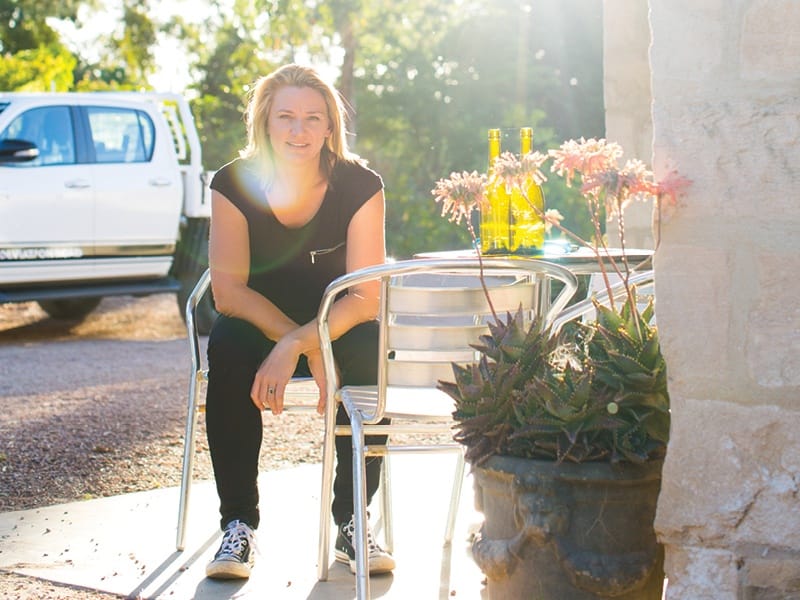
She is best known for sparkling but Deviation Road’s Kate Laurie has a few other tricks up her sleeve.
When Wine Australia invited Kate Laurie to Parliament House in February to pour wine for a bunch of pollies, she was quietly chuffed. “I’m going to wear a nice frock,” she said before the event. “I’m hosting a table for sparkling… we’ll see if they like the wine or if they just like shit wine.”
If anyone is to be trusted with educating our nation’s leaders about bottle-fermented and aged Australian sparkling wines, it’s Kate, though she’s more comfortable in her vineyard clobber at the 130-acre property she runs with hubby Hamish Laurie.
Deviation Road Winery occupies a beautiful part of the world. Kate and Hamish spotted it 13 years ago. “We were selling our little house in Stirling and looking for a five-acre garden because Hamish likes gardening,” Kate says. “This was on the market so we thought we’d have a look.” The property belonged to a 90-year-old lady called Gladys who wouldn’t let people drive cars up the driveway. “We jumped the fence at the top of the property and went through the scrub and found this huge lake up there. It was instant love.”
The lake is surrounded by heritage-listed native vegetation and the couple and their three daughters (Eliza, 12, Emily, 11, and Annabel, 7) retreat there for camp outs, picnics and quiet moments. Not that they get many. They’ve established vineyards, converted a 1940s dairy into a winery, built a cellar door, and established a name for themselves in handcrafted bubbles.
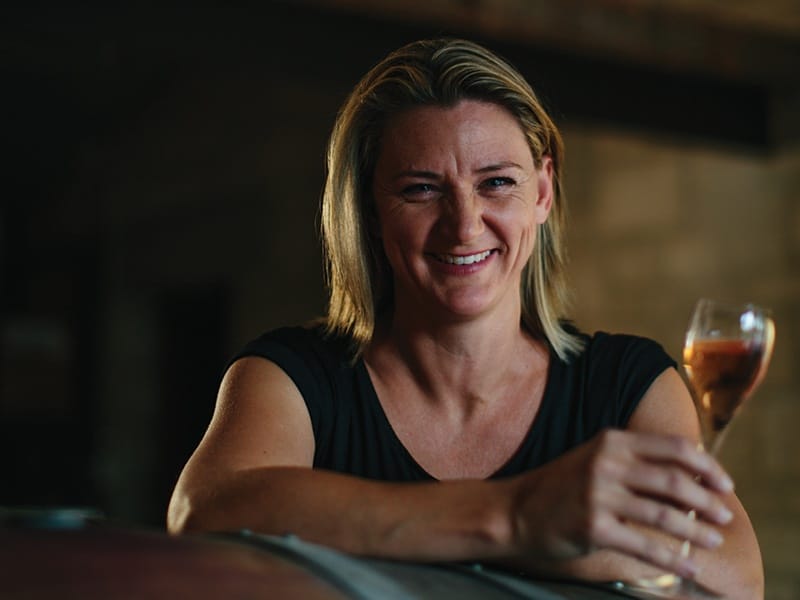
“Sparkling is definitely the core of our DNA, however I think most would be surprised to know that our sparkling wines make up only half of our annual production. I’m lucky that I’m able to play around with a multitude of varieties like gris, grüner, and shiraz, as well as using some of the pinot and chard for still wines. The styles and approach are so different yet equally as challenging, so I consider myself really lucky to work for myself and be able to play with all varieties. This is certainly our addition to the family history.”
Five generations of winemaking experience preceded them. In 1848, Mary Laurie (Hamish’s great, great, grandmother) was South Australia’s first female winemaker. Hamish worked alongside his father and created Hillstowe wines in 1991. They sold the successful international brand in 2001 and Hamish built his own winery.
“Hamish had just created Deviation Road when I met him. The name is based on the road the Carey Gully vineyard is on. It’s the vineyard we still get most of the fruit from.”
The winery is actually on Scott Creek Road in Longwood. The name stuck, however.
My maiden name is Hooker so we couldn’t use that, though Nick Ryan uses it whenever he can – in front of 500 people, once. ‘There’s my favourite Hooker!’.
Recent additions include high-altitude sites in the Piccadilly Valley, Mount Lofty (the highest vineyard in the Hills) and a second site in Carey Gully. Their signature Loftia Vintage Brut is aged for a minimum of 24 months on lees and is a blend of pinot noir and chardonnay grapes from mature vines on south-facing slopes.
Kate is originally from Perth. During high school, her father planted a vineyard. “I loved science, chemistry and maths, so when I discovered that wine was basically an applied science but with the outdoor and physical elements, it fulfilled my needs.”
An obsession with France led her down the bubbles path. “Dad used to import Poclain Hydraulics motors just north of Paris. The export manager would have dinner with us and I’d try to talk French with him.” He invited her to visit, so she saved her pennies and spent the Australian summer holidays there.
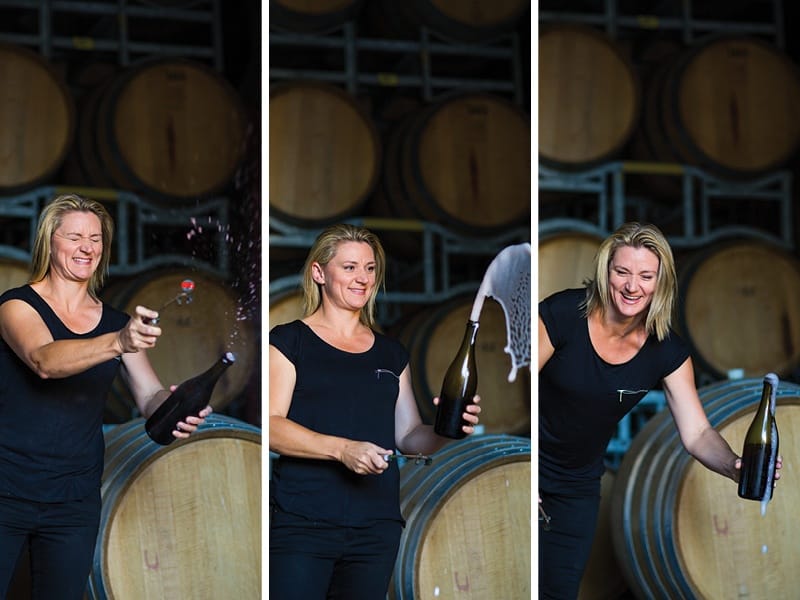
Kate studied a year of ag science but was bored by the lack of wine focus, so she went back to France to help out a winery and was invited to study an advanced diploma in viticulture and oenology at Lycée Viticole d’Avize in Champagne. “You get intellectual stimulation as well as creative and physical. It’s also social because everyone catches up to taste wine and talk – it’s such a way of life. In this industry you can take it as far as you like with the science. You can get down to the molecular level of the wine, and at other times it’s hard yakka – your brain is shut off because you’ve got so much to do.”
Kate returned home to make wine with her dad at the family’s winery Stone Bridge, and found a distributor in Sydney and Melbourne – the same distributor for Hillstowe, the brand Hamish used to own with his dad. The pair met and the rest is history.
The move to South Australia was a no-brainer. “It feels much more like that French environment where everyone is in it together. The industry is so ingrained here. People share ideas much more freely. When I arrived on the plane, Chester Osborn picked me up and next thing we’re dancing to Rage Against The Machine and talking about how to make pinot noir.”
Kate continued her traditional sparkling journey after her dad gifted her equipment he bought back from Champagne. “I wanted to have that control over tirage and disgorging, so when Dad said I could have the equipment, we decided to go with the sparkling here in the Hills. I didn’t want to send it off to someone else; I would have lost the control and the intimate relationship with my own wine.”
To her other wines, she applies the discipline she learnt in Champagne. It’s all about méthod traditionnelle. “Even though our production volumes have grown significantly lately, we still opt for man power and our basic bottling line for tirage (bottling). We disgorge small batches at a time on-site also, giving us control over every step of the process. We like to disgorge on demand to ensure most of the stock benefits from extended lees ageing as much as possible.”
She loves the blending and disgorging part of the process. “Disgorging is great because it’s the final point at which you can touch the wine. You get the sugar balance right with the dose, and if there’s anything else I want to tweak I can do it then.”
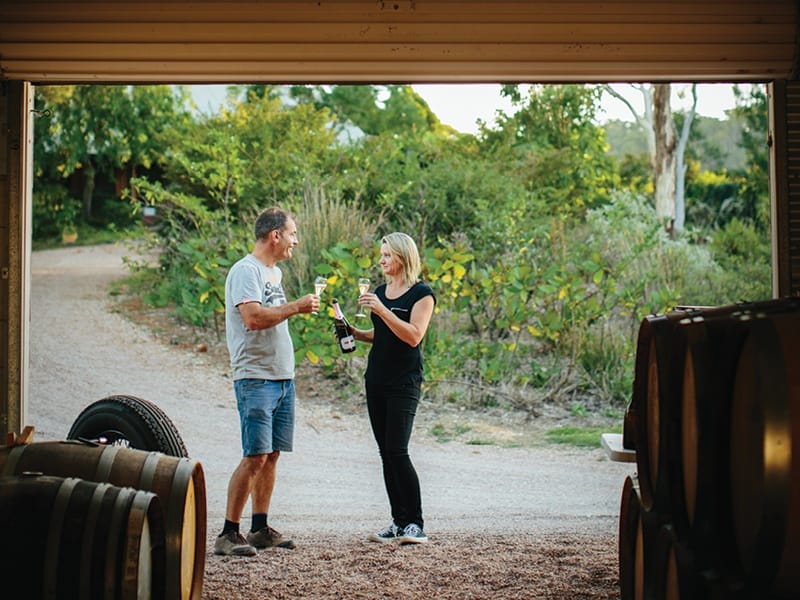
Unfortunately, there’s no sparkling crystal ball. “What you put in the bottle can turn out nothing like what you want it to. There’s no other wine style like that. Every time you touch the wine it can have a downstream process implication which you might not see until you’re disgorging.”
It’s one of the reasons few winemakers want to make sparkling. “If anything goes wrong, it doesn’t ferment in the bottle – you’ve got a whole lot of acidic, disgusting wine that you’ve got to tip back out and try to fix. Tirage is very stressful.”
She says the care that goes into a traditionally made glass of the good stuff is lost on many consumers. “We need to make more of a change to the label in Australia, to make sure that people understand when it’s carbonated like a SodaStream. The traditional method means it is made with every bottle as individual.”
It’s the reason Deviation Road runs paid masterclasses. These include sparkling and Champagne demonstrations, and sessions about the disgorging process. “They all leave going ‘I had no idea’ and don’t mind spending a little bit more for a bottle that has gone through that process.”
The cellar door – a transportable building fitted to the environment – is the base for many weddings, Adelaide Fringe events, the odd Pink Floyd tribute concert and Adelaide Hills Crush Festival events. “It’s been really crucial to growing awareness of us being here because we’re not in the cluster of Hills wineries, we’re a destination.”
Event marketing is mostly done via social media, something Kate has little time for, especially during vintage. “Even though I’m making 100 tonne this year, I still treat it like I’m making 10 because I want it to be perfect.” They’re thrilling, stressful times. “I’m not happy if I don’t pick on the day I want. The thing about sparkling is, it has to be pure. I can’t afford it to sit there in the heat in the picking bins. I want to get it pressed and to juice pretty much instantly. In Champagne, they have pressing houses all around so the fruit gets picked and straight into the nearest press house and off the skins straight away. The cool mornings are when they pick. With Australia’s heatwaves, picking can turn into quite a nightmare.”
Kate and Hamish have defined business roles, though they often overlap. Hamish runs the business: sales, marketing, cellar door. Kate handles production and winemaking.
When I’ve got blends to pre-bottle, Hamish and I will sit down to make sure he’s happy with the blend or wants to try something different. We play around with that creative fun part together as well.
Kate also has a second degree in molecular biology and genetics at Flinders University, just in case they ever need a back-up. However, that seems unlikely.
“We’re really at capacity now so we need to build some more sheds. We’ve also got a back paddock I’d like to plant out to increase the holding by about five acres. Maybe pinot gris and chardonnay. As we’ve grown, we’re buying more fruit from other growers – we buy about half in now so it’ll be nice to keep picking a portion of homegrown fruit.”
In the vineyard it’s all about best practice. “We bought this property for the natural beauty that surrounds us, and heritage listed 80 percent of the land to protect the rare plant species that are on it. Our approach to the vineyard is about balance and working within the elements of this environment. The soils here are pretty thin, so Hamish is working on building up organic matter under the vines, and establishing inter-row cover to naturally improve soil nutrient content and structure.”
They aim to make the best wine with the fruit they’re given each year. “The hard years are the better ones as a winemaker because you learn and you’re challenged and pushed. When you get perfect fruit, you just have to nurture it.”
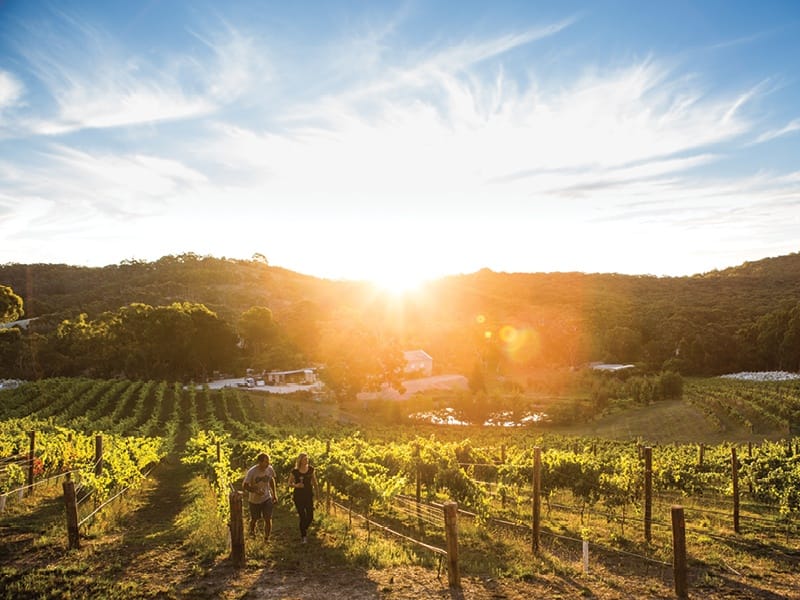
Kate’s never actually worked under a senior winemaker. “I used to think that was a bit of a shame but now I think it’s been a blessing because the style is definitely what I want to make. Having said that, every mistake you make is an expensive one and all on your own shoulders.”
Thankfully, she hasn’t made too many, though she remembers one distinctly. “In 2011, I made a sparkling shiraz that was completely undrinkable. Applying what I knew about sparkling whites didn’t directly translate to sparkling reds. The parameters are quite different, which caught me by surprise. This wine never made it to market – fortunately it was only a barrel’s worth so our marriage survived, too.”
Accolades
Kate was a Gourmet Traveller Winemaker of the Year 2016 finalist (Giant Step’s Steve Flamsteed took the crown). “It was a pretty big year last year. I went to The Len Evans Tutorial as well,” Kate says. “Wine shows can sometimes be like a lottery but when we won our first trophy at Adelaide Hills Wine Show with the sparkling, that was definitely a turning point, with the industry noticing us and what we’re doing. To win a second one the second year… that was more stressful for me than the first. You can’t help but think, ‘I hope I’m not a one-hit wonder’. I was much more relieved to follow it up with another accolade. They definitely help. It’s a good way to break through. It was 2011–12 when we started winning the awards for our previous vintage wines so that made a big difference to the business.”
The export market
“We export a tiny bit. We’ve just sent some to Japan, Germany, Canada and the UK (where we’re competing with Champagne). That’s another reason I’m trying to get us recognised for the grüner. The grüner is kicking it. That wine is fantastic. We haven’t really felt the need to go to China yet. We’ve had enquiries but our volumes aren’t high enough and I don’t want ‘huge amounts of a particular wine that we don’t normally make’ kind of odd requests.” For now, Deviation Road focuses on domestic supply. They signed on with national distributor Negociants two years ago.
Women in wine
Media are always keen to bring up the ‘challenges of a woman making it in a man’s world’ angle but Kate has never had an issue. “I haven’t felt like I was underpaid – in fact, the opposite. My father always taught me to believe I can do anything. Hamish’s expectation of me is that I can do everything. Pay needs to be addressed across the board. The wine industry is fantastic and we should be putting a positive message out there: ‘Look at us. Look at how many women are going through university wanting to be winemakers and how can we mentor them through that next stage?’ Kate declines involvement on female-specific events. Instead, she mentors young girls. “I see that as a much more valuable role – to make girls feel that this industry has something for them later. I want to be a positive role model. I do get a lot of females asking for jobs out of the blue and I don’t get many blokes. I don’t know if it’s because they really want to work with sparkling or they feel more comfortable approaching a woman and want a woman boss. But I do think we’re a very positive industry in the scheme of things.”
Marketing rules
When aligning themselves with brands and deciding on event sponsorship, Deviation Road tends to gel with anything food, culture, art, music, or book related. They often supply wine to local Matilda Book Store, especially if the book launch is about or written by a chef. “We sponsored a couple of events last year – one was a motorsport festival and one was Adelaide Fashion Festival. It was quite obvious that the fashion festival alignment was perfect – I was down there pouring the wines and people were coming up and going ‘We love your bubbles’. They knew us, they appreciated us, and they were in tune with what they were drinking.”
Related content
Latest cover story
An Hour with Renae Hirsch, the quiet achiever in wine







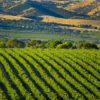


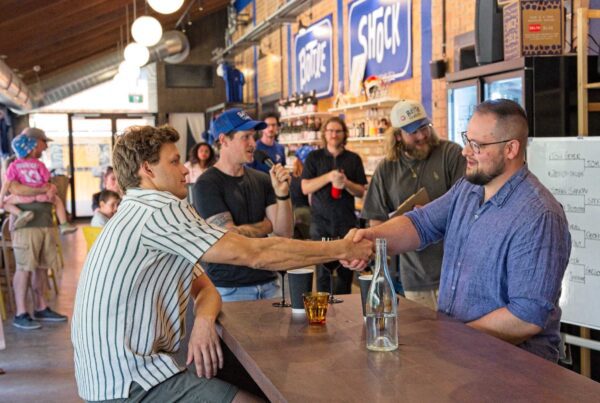

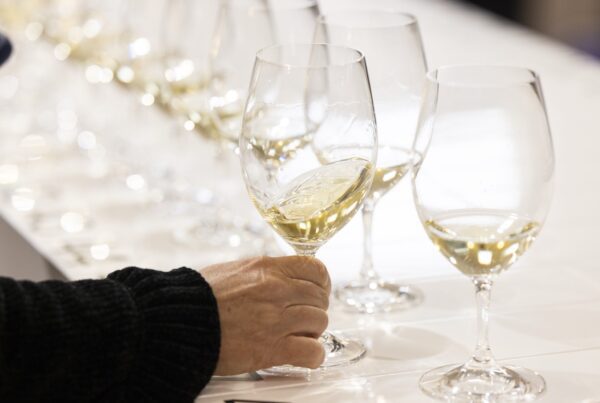
Recent Comments